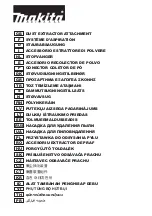
Fig. 10
Fig. 10a
1
2
To prevent the wires of the cabling inside the circuit-
breaker (made by the customer) from accidentially
touching moving parts (which would damage their
insulation), make sure that they are positioned and
fixed as shown in fig. 10a.
In both types of connection, the wires must pass
through connection (2) while outside the circuit-
breaker, they must be screened by an appropriate
sort of metallic protection (tube, duct, ...), which
must be earthed.
7.8.2. Withdrawable circuit-breaker
The auxiliary circuits of the withdrawable circuit-
breaker are fully wired in the factory through to the
connector (fig. 11).
Refer to the circuit diagram of the switchgear for
the external connections.
Fig. 11 VD4G circuit-breakers for UniGear switchgear
7.7. Earthing
The fixed version of these circuit-breakers is ear-
thed by means of the dedicated screw identified by
the relative symbol. Clean and degrease the area
around the screw over a diameter of about 30 mm
and, after assembly, cover the joint with Vaseline
grease.
Use a conductor (busbar or braid) with a cross-
section conforming to the Standards in force.
7.8. Connection of auxiliary circuits
Note: the minimum cross-section of the wires used
for the auxiliary circuits must not be less than the
section used for internal cabling. The wires must
also be insulated for 3 kV test voltage.
7.8.1. Fixed circuit-breaker
The auxiliary circuit can be connected in two
different ways inside the circuit-breaker, depending
on the type chosen by the customer.
The first type is supplied as the standard version. In
this case, the auxiliary contacts must be
disassembled from the structure of the circuit-
breaker, since their terminals cannot be directly
accessed (fig. 10) (consult the installation manual).
The wiring is made during the production phase for
the second type.
This means that the customer can directly wire up to
terminal boxes in the front part of the circuit-
breaker. In this case, the wiring operation is much
faster and immediate.
M ED I U M VO LTAG E PRO D U C T S
29
















































